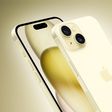iPhone 4S Includes Significant Antenna Upgrades
Apple has built significant antenna upgrades into the iPhone 4S, saying in the press release announcing the phone that it is the first phone to intelligently switch between two antennas to send and receive. We spoke to Spencer Webb, owner of AntennaSys, about the antenna history of the iPhones. He wrote extensively about the AntennaGate issues with the original iPhone 4 last year.
"With the iPhone 4," Webb explained, around the steel band "we had one cell antenna at the bottom. On the top, we had another antenna for GPS and Wi-Fi." This turned into Antennagate.

With the Verizon/CDMA iPhone, Webb believes Apple's designers "moved the GPS and Wi-Fi antennas beneath the back glass and turned the top antenna into a second antenna for the cell phone." This brought spatial diversity to the iPhone. This design helps solve the Antennagate problem, because the phone can switch between the antennas depending on signal conditions.
"If you cover up an antenna, you're probably not covering up both antennas," Webb explains. "Spatial diversity on the receiving side is required for use with the Verizon network."
The Verizon iPhone had 'receive diversity' -- it used two antennas for receiving data, but may have only transmitted on the bottom antenna. With the iPhone 4S, Apple claims to have both 'send and receive diversity' for GSM and CDMA. They're using this diversity as the solution to the antenna problem.
"The iPhone 4S may indeed be the first phone to have diversity on both the send and receive sides, and that is a decently big deal. They still have the antenna around the rim, though, so it's evolutionary, not revolutionary."
Image via This Is My Next
Popular Stories
The first beta of iOS 18.4 is now available, and it includes a small but useful change for CarPlay.
As we noted in our list of iOS 18.4 features, CarPlay now shows a third row of icons, up from two rows previously. However, this change is only visible in vehicles with a larger center display. For example, a MacRumors Forums member noticed the change in a Toyota Tundra, which can be equipped...
In an all-caps post on Truth Social today, U.S. President Donald Trump said Apple should fully end its diversity, equity, and inclusion (DEI) policies.
Tim Cook meeting with President Trump in 2017
"APPLE SHOULD GET RID OF DEI RULES, NOT JUST MAKE ADJUSTMENTS TO THEM," he wrote.
Trump's post comes one day after Apple held its annual shareholders meeting, during which a majority of...
The Apple Watch Ultra 3 is expected to launch later this year, arriving two years after the previous model with a series of improvements.
While no noticeable design changes are expected for the third generation since the company tends to stick with the same Apple Watch design through three generations before changing it, there are a series of internal upgrades on the way.
By the time the ...
Apple is making significant headway on its long-rumored foldable iPhone, with a new report suggesting the company has achieved a major breakthrough by effectively eliminating the screen crease that plagues current foldable devices.
According to Korean publication ETNews, Apple is finalizing its component suppliers for the foldable iPhone, with the selection process expected to be completed...
Apple plans to launch a second-generation AirTag in May or June this year, according to a post today from a leaker known as Kosutami.
Bloomberg's Mark Gurman previously reported that a new AirTag would be released in mid-2025. May or June would align with that timeframe.
Below, we recap three new features rumored for the AirTag 2:
With a second-generation Ultra Wideband chip, the...
A new CAD render of all the devices in Apple's upcoming iPhone 17 lineup has been shared online by leaker Majin Bu, specifically showing the allegedly different rear camera system designs of the standard iPhone 17, all-new ultra-thin iPhone 17 Air, and the iPhone 17 Pro and Pro Max models.
The leaker Majin Bu has had some hits in the past, but some of his information has been wrong,...
In a recent press release, Apple confirmed that iOS 18.4 will be released in April.
From the Apple News+ Food announcement:Coming with iOS 18.4 and iPadOS 18.4 in April, Apple News+ subscribers will have access to Apple News+ Food, a new section that will feature tens of thousands of recipes — as well as stories about restaurants, healthy eating, kitchen essentials, and more — from the...
Multiple iPhone owners today noticed a pronunciation processing issue that causes the word "Trump" to momentarily show up when using dictation to send a message with the word "racist."
In some cases, when speaking the word racist through the iPhone's built-in dictation feature, the iPhone briefly interprets the spoken word as "Trump" and "Trump" text shows up in the Messages app before being ...























